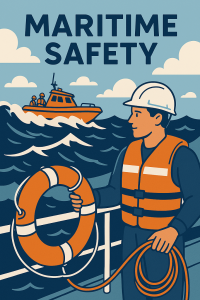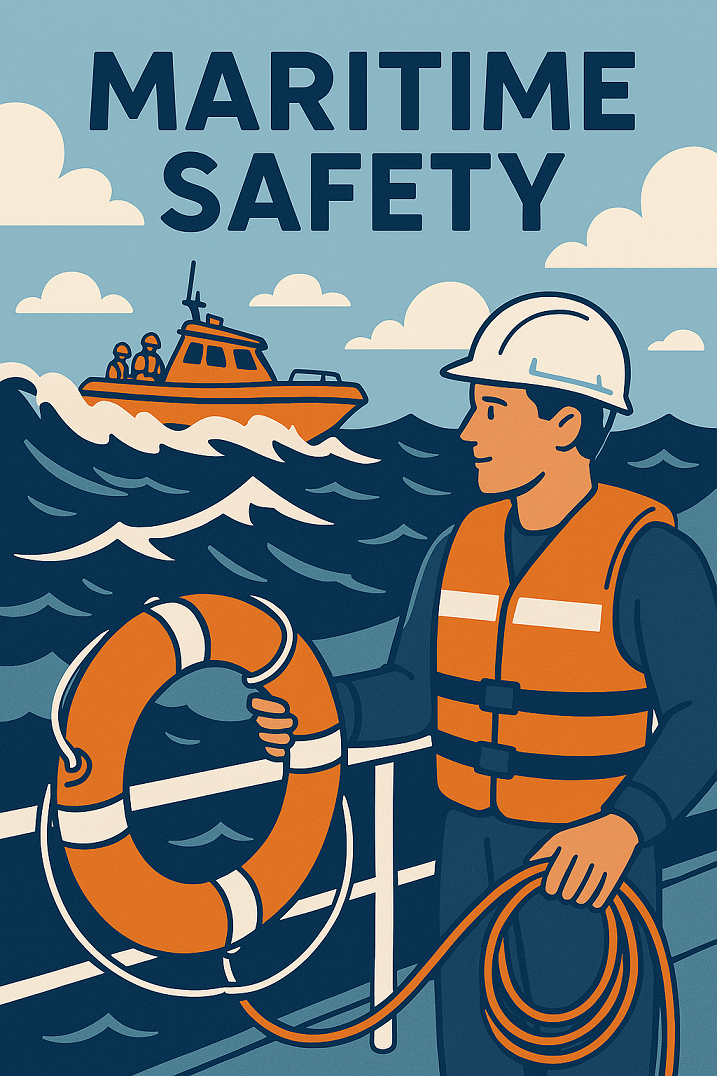Discover the fundamentals and best practices of maritime safety, from SOLAS regulations to safety drills, equipment, and training. An essential guide for maritime students, cadets, ship officers, shipping companies, and seafaring professionals.
Why Is Maritime Safety Critical?
Every year, thousands of vessels navigate some of the world’s most unpredictable environments—from turbulent oceans to congested ports. In these dynamic settings, maritime safety is not just a regulatory requirement—it’s a matter of life and death.
Whether you’re a maritime student, cadet, ship officer, or part of a shipping company, understanding maritime safety is vital to minimizing risks, protecting lives, and ensuring operational efficiency at sea.

What Is Maritime Safety?
Maritime safety refers to all measures, systems, procedures, and regulations designed to ensure the safe operation of ships, protection of crew and passengers, cargo integrity, and preservation of the marine environment.
It encompasses:
-
Preventive actions (design, training, safety checks)
-
Corrective actions (emergency response, firefighting, rescue)
-
Regulatory frameworks (SOLAS, STCW, MLC)
⚓ The ultimate goal of maritime safety is zero accidents, zero pollution, and total preparedness.
Key Concepts and Foundations
🚢 1. SOLAS (Safety of Life at Sea)
-
Introduced after the Titanic disaster in 1914
-
Sets global standards for ship design, construction, equipment, and operational safety
-
Enforced by the International Maritime Organization (IMO)
🧯 2. STCW Convention
-
Sets standards for training, certification, and watchkeeping for seafarers
-
Includes mandatory safety training such as:
-
Basic firefighting
-
Personal survival techniques
-
First aid
-
Personal safety and social responsibility
-
🛟 3. MLC 2006 (Maritime Labour Convention)
-
Ensures health, welfare, and working conditions for seafarers
-
Mandates safe accommodation, hygiene, rest hours, and medical care
Essential Safety Practices Onboard
✅ Safety Equipment Checklist
-
Life jackets and immersion suits
-
Lifeboats and rescue boats
-
Fire extinguishers and fire hoses
-
Emergency lighting and alarms
-
Breathing apparatus (BA sets)
🚨 Safety Procedures and Drills
-
Weekly safety drills: Fire, abandon ship, and man overboard
-
Muster lists and emergency signals training
-
Permit-to-work systems for hazardous operations (e.g., enclosed space entry)
🧠 Safety Culture and Human Element
-
Promoting a “safety-first” mindset among crew
-
Addressing fatigue, communication breakdowns, and human error through:
-
Toolbox talks
-
Risk assessments
-
Just culture environments
-
Real-World Applications & Case Studies
🔹 Case Study 1: The Costa Concordia Disaster (2012)
-
Poor emergency preparedness and navigational errors led to 32 fatalities
-
Reinforced the importance of emergency response training and bridge resource management
🔹 Case Study 2: Explosion on Chemical Tankers
-
Root causes: Improper cargo handling, lack of risk assessment
-
Highlights the need for cargo-specific safety protocols
🔹 Case Study 3: Fire on Ro-Ro Ferries
-
Common causes include unattended vehicles, electrical faults, and poor ventilation
-
Emphasizes regular fire patrols and cargo deck safety systems
Latest Trends and Innovations in Maritime Safety
🌐 1. Digital Safety Management Systems (DSMS)
-
Cloud-based platforms for real-time safety reporting, inspections, and compliance tracking
🛰️ 2. Remote Safety Monitoring
-
Use of IoT sensors for fire detection, gas levels, hull integrity, and machinery temperature
🤖 3. Virtual Reality (VR) and Simulators
-
VR used for lifeboat launching, engine room emergencies, and bridge navigation drills
-
Enhances seafarers’ readiness without physical risks
🌱 4. Environmental Safety
-
Ballast water management, fuel emissions control (EEXI/CII), and oil spill response
-
Crosslinked with safety protocols due to the dual risk to crew and the environment
Career Relevance: Why Maritime Safety Matters
👨🎓 For Students & Cadets:
-
Foundation of professional competency and STCW qualifications
-
Builds confidence to face onboard emergencies
⚓ For Officers & Engineers:
-
Responsible for enforcing safety routines, drills, and inspections
-
Must report near-misses and improve safety culture
🏢 For Shipping Companies:
-
Reduces accident rates, downtime, and insurance premiums
-
Essential for regulatory compliance and flag/state inspections
FAQs: People Also Ask
What is the SOLAS Convention?
The Safety of Life at Sea (SOLAS) Convention is the most important international treaty concerning maritime safety, covering construction, equipment, and operation standards.
What is the difference between maritime safety and maritime security?
-
Safety focuses on protecting life, cargo, and the environment from accidents and technical failures.
-
Security deals with intentional threats such as piracy, terrorism, and smuggling.
Why are safety drills important?
They help crew members respond quickly and effectively during real emergencies like fire, collision, or man overboard situations.
What are some common causes of maritime accidents?
-
Human error
-
Equipment failure
-
Poor maintenance
-
Inadequate training
-
Fatigue and communication breakdowns
Conclusion: Safety at Sea Is Everyone’s Responsibility
Maritime safety is not optional—it’s essential. From the bridge to the engine room, every crew member plays a role in keeping the vessel, cargo, environment, and lives secure. With advancing technologies and evolving regulations, maritime professionals must stay informed, trained, and vigilant.
⚓ Next Steps:
-
Enroll in Advanced Maritime Safety Training

